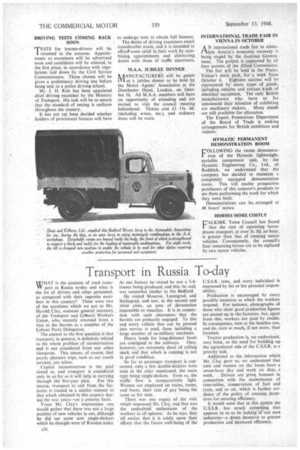Transport in Russia To - day /HAT is the position of road
Page 28

If you've noticed an error in this article please click here to report it so we can fix it.
transIT port in Russia to-day and what is the lot of drivers and other personnel, as compared with their opposite numbers in this country? These were two of the questions which we put to Mr. Harold Clay, assistant general secretary.. of the Transport and Gefieral Workers Union, who recently returned from a visit to the Soviets as a member of the Labour Party Delegation.
• The answer to the first question is that transport, in general, is definitely related to the whole problem of reconstruction and is not considered fromany other Viewpoint. This means, of. course, that purely pleasure trips, such as our coach
services, are taboo. • Capital reconstruction is the goal aimed at, and transport is considered only in so far as it will help in carrying through the five-year plan. For this reason, transport to and from the facTories is treated in a similar manner to that which obtained in this country during the war years—on a priority basis.
From Mr. Clay's impressions one would gather that there was not a large number of new vehicles in use, although he did see some new single-deckers which he thought were of Russian make. At one factory he visited he saw a 3-4tonner being produced, and this, he said, was somewhat similar to the Bedford.
He visited Moscow, Leningrad. and Stalingrad, and saw, in the second and third cities, an area of devastation impossible to visualize. It is in connection with such clearances that the Soviets are primarily engaged. To this end every vehicle that can be pressed into service is. used, these including a large number of ex-military machines.
Heavy loads for long-distance hauls are consigned to the railways. They, however, are extremely short of rolling stock and that which is running is not in good condition.
So far as passenger transport is concerned, only a few double-deckers were seen in the cities mentioned, the main type being single-deckers. Even so, the traffic flow is comparatively light. Women are employed On trains, trams, and buses, their rate of pay being, the same as for men.
There, was one aspect of the visit which impressed Mr. Clay. and that was the undoubted enthusiasm of the workers in all spheres. As he says, they all realize that it is solely upon their efforts that the future well-being of the U.S.S.R. rests, and every individual is impressed by his or her personal responsibility.
Production is encouraged by every possible incentive to which the workers respond. For instance, photographs of those who show good production figures are posted up in the factories, but, apart from this, workers are paid by results. In consequence, men at the benches can, and do, earn as much, if not more, than foremen.
Tractor production is, we understand, very, brisk, as the need for building up the agricultural side or the U.S.S.R. is a priority task.
Additional to the information which Mr. Clay gave us. we understand that men and women on the buses have a seven-hour day and work six days. a
week. Drivers are given bonuses. in connection with the maintenance of time-tables, conservation of fuel and tyres, and so on, which is further evidence of the policy of creating incentives for. securing efficiency.
It would seem that in this SYstetn the U.S.S.R. has struck something that appears to us to, be lacking iii"our own industries—a direct incentive to greater production and increased efficiency.




































































